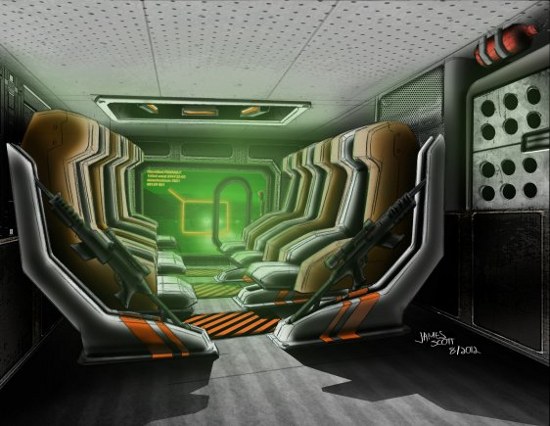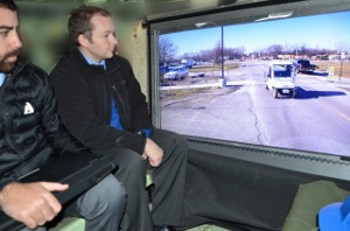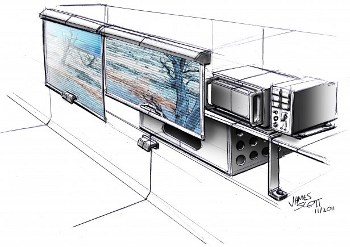 |
| April 09, 2013 | Volume 09 Issue 14 |
Designfax weekly eMagazine
Archives
Partners
Manufacturing Center
Product Spotlight
Modern Applications News
Metalworking Ideas For
Today's Job Shops
Tooling and Production
Strategies for large
metalworking plants
'Virtual Window' aims to provide vital view for Soldiers
Army researchers at the Detroit Arsenal in Michigan are looking for ways to give Soldiers a look outside using cameras and monitors while on patrol.
To provide better situational awareness for Bradley Fighting Vehicle Infantrymen, a cross-discipline team of U.S. Army Research, Development, and Engineering Command engineers is developing the "Virtual Window" -- a video display mounted to the interior of the rear ramp that provides the Soldiers a comprehensive environmental view before they dismount the vehicle.

This rendering proposes a Virtual Window screen across the rear ramp of an armored vehicle. It gives Soldiers riding in the vehicle a critical picture of their surroundings. [Photo Credit: Sketches by U.S. Army TARDEC designer James Scott]
Contemporary military vehicles, such as the family of Mine-Resistant Ambush-Protected vehicles, have several transparent armored windows Soldiers can use to survey the area around them. When Soldiers ride in a Bradley, they're surrounded by protective armor and cannot see the area around them or know what they will encounter outside the vehicle once the rear ramp is lowered and they deploy.
The virtual window display helps minimize surprise when the ramp descends and the crew deploys from the vehicle. Soldiers can step on the reinforced screen without damaging it as they exit the vehicle.
"We integrated a high-definition camera onto the rear of a Bradley Infantry Fighting Vehicle and then integrated a commercial 46-inch LED display into the ramp," said Tank Automotive Research, Development and Engineering Center (TARDEC) engineer Andrew Kerbrat. "The video feed from the camera appears on the display, which gives Soldiers the ability to see outside the vehicle with the ramp closed. This visual situational awareness could be a game-changer in how the Soldier proceeds out of the vehicle."

TARDEC Engineers John-Taylor Smith (left) and Shawn Keller test the Virtual Window demonstrator at the Detroit Arsenal, Mich. [Photo Credit: U.S. Army photo]
To generate ideas for the Virtual Window design, the project team organized an Innovations Solutions training event consisting of design students and professors from the College for Creative Studies in Detroit, plus Army Warrant Officers from the U.S. Army Ordnance School who provided their experience and technical knowledge to the students who created numerous sketches for the Virtual Window concept. A second Innovations Solutions Workshop is being planned for this May.
As a follow-up to the workshop, the team has already started working on Virtual Window 2, which expands the system's capabilities and will be integrated into and tested on a Stryker Infantry Carrier Vehicle.
Possible enhancements for the Virtual Window 2 phase could involve driver and commander crew stations connected to the new display system to provide broader levels of situational awareness for the four-member squad, including:
- 360-degree visual situational awareness through electro-optical sensors.
- Thermal viewer through a commander's Gimbal for medium-range situational awareness capability.
- Unmanned Ground Vehicle Command and Control with video feed displayed on the Virtual window.
- Video feed from a remote Soldier camera fed back to an ICV and displayed on screen.
- Remote mission planning from a tablet provided to the virtual window.
- Force XXI Battle Command Brigade and Below capability displays.
"We are trying to move the technology toward the idea of the vehicle as a member of the squad," Kerbrat said.
The technology concept can be applied to other vehicles as well, he said.

Pull-down screens showing other perspectives outside the vehicle may be included in the Virtual Window 2 phase design. [Photo Credit: Sketch by U.S. Army TARDEC designer James Scott]
"Not all vehicles would be able to take a wholly integrated system, but some subsystem technologies have relevance in current and future vehicles," he said. "For example, we're using versions of the Soldier Machine Interfaces for many projects ranging from command and control of small unmanned ground vehicles all the way to integration into MRAP vehicles involved in today's fight."
The project involves an integrated team effort that bridges several TARDEC technical areas, including Ground Systems Survivability, Ground Vehicle Robotics, Vehicle Electronics and Architecture, Ground Vehicle Power and Mobility's battery team, and the Center for Systems Integration.
The group worked with the Communications Electronics Research, Development, and Engineering Center's Night Vision and Electronic Sensors Directorate, which provided the sensor suite that allowed the team to employ many capabilities for the Virtual Window 2 phase. CERDEC also helped develop and integrate base technologies for the system.
TARDEC's Ground Systems Engineering, Assessment, and Assurance team provided vehicle information for Virtual Window 1 and set up the first Innovations Solutions Workshop, Kerbrat said. Also, the Maintenance Operations Center provided training space and storage, and assisted with related maintenance issues.
Source: TARDEC
Published April 2013
Rate this article
View our terms of use and privacy policy
